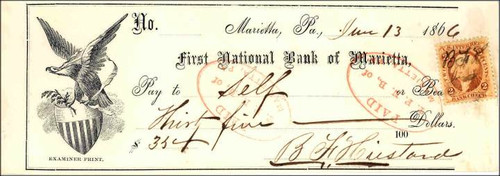Beautifully engraved check from the Merchants National Bank issued in 1866. This historic check has is hand signed by Joel Munsell and is over 134 years old. There is a George Washington two cent tax stamp attached to the check. Massachusetts-born Joel Munsell (1808-80) was the first great Albany antiquarian. Settling in Albany in 1827, this Yankee printer turned publisher and businessman began to collect historical clippings, documents, and maps and also encouraged long-time residents to write down and sketch their memories of earlier times. Of the dozens of local contacts he initiated, his liaisons with businessman/directory publisher Joseph Fry, librarian/translator Jonathan Pearson, and scientist/artist James Eights would have long term significance. Munsell nurtured and prodded his neighbors' recollections into manuscripts and views. Apparently he took great care to have them reconciled with the community's actual historical record. He also engaged lithographers and other printmakers to transform descriptions and sketches into more formal portraits, maps, and views that could be utilized to illustrate and decorate his publications. An avid collector of Americana since childhood, by the 1840s Joel Munsell had accumulated a large and wide-ranging archive of materials related to the history of his new home. At that time, he began to print selections from his historical collection - first in almanacs and historical calendars, then in other more miscellaneous publications, and later in two multi-volume compendiums of historical information and art called The Annals of Albany (10 volumes issued between 1850-59) and the Collections on the History of Albany (4 volumes issued 1865-71). Over the course of a long career as collector, compiler, editor, and antiquarian printer, Joel Munsell was responsible for the publication of hundreds works on Albany history. Today, Munsell's publications representing the core of Albany's historical legacy, have remained remarkably accessible in a number of forms, and have been of inestimable value to the Colonial Albany Social History Project in its efforts to reconstruct the early Albany community from the bottom-up. Because of their accessibility and visual clarity, Munsell-inspired maps, portraits, and views are utilized by the Colonial Albany Project on this website and in all project programs. However, despite their obvious value, we must continually be aware that they are highly selective re-creations, not authentic pre-industrial resources despite their very credible appearance . Like most antiquarian works, the images presented by Joel Munsell made the past appear attractive to viewers/potential patrons by idealizing the best of antiquity, neutralizing the more mundane and commonplace scenes and situations, and avoiding (sometimes even romanticizing) poverty, suffering, and other more gruesome aspects of life. In retrospect, such romantic representations make us look back on what, in reality, was a very difficult existence with fondness and even longing as "the good old days." At the same time, the bucolic nature of life presented by Munsell and other antiquarians stands in stark contrast to the arduous existence emerging from the research conducted by the Colonial Albany Project. Admittedly, the Colonial Albany Project has succumbed to the lure of antiquarian art as these images have permitted us to visually interpret the lives of people who would not have been in a position to commission a portrait, whose homes were simply replaced, and who have left behind little literary evidence of their early Albany lives. Corroborated by wide-ranging historical research - that also often was basic to their creation, creditable historical artwork represents a powerful resource for understanding and interpreting the early Albany story. The above history was obtained from the Colonial Albany Social History Project at http://www.nysm.nysed.gov/albany/welcome.html.
Merchants National Bank 1866 signed by famous publisher Joel Munsell
MSRP:
Was:
Now:
(Inc. Tax)
MSRP:
Was:
Now:
$49.95
(You save
)
Write a Review

Merchants National Bank 1866 signed by famous publisher Joel Munsell
- SKU:
- mernatban
- UPC:
- Gift wrapping:
- Options available

Add to Cart
The item has been added
Merchants National Bank check signed by Famous Whaler, Andrew Hicks - New Bedford, Connecticut 1860
MSRP:
Was:
Now:
(Inc. Tax)
MSRP:
$129.95
Was:
Now:
$99.95

Add to Cart
The item has been added
Northfield National Bank 1866
MSRP:
Was:
Now:
(Inc. Tax)
MSRP:
$119.95
Was:
Now:
$89.95

Add to Cart
The item has been added
Merchant's National Bank - Richmond, VA 1901
MSRP:
Was:
Now:
(Inc. Tax)
MSRP:
$39.95
Was:
Now:
$29.95

Add to Cart
The item has been added
First National Bank of Marietta 1866-1869 Pennsylvania
MSRP:
Was:
Now:
(Inc. Tax)
MSRP:
$39.95
Was:
Now:
$29.95

Add to Cart
The item has been added
Merchants National Bank Check 1874 - East Saginaw
MSRP:
Was:
Now:
(Inc. Tax)
MSRP:
$24.95
Was:
Now:
$14.95
!


